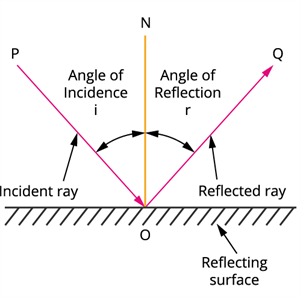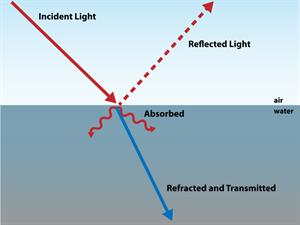
PUMPA - SMART LEARNING
எங்கள் ஆசிரியர்களுடன் 1-ஆன்-1 ஆலோசனை நேரத்தைப் பெறுங்கள். டாப்பர் ஆவதற்கு நாங்கள் பயிற்சி அளிப்போம்
Book Free DemoWhat happens when light strikes a mirror?
Mirror:
A mirror is a material made up of glass having a shiny surface.
When light falls on a mirror, it is reflected back. A mirror changes the direction of light that falls upon it.

Reflection of light
Here we introduce a new concept called reflection. Let us discuss reflection in detail.
Reflection:
The bouncing back of light from a smooth surface is called reflection. Smooth polished surfaces called mirrors can reflect light falling on them in any direction.
A still water body like a pond reflects the scenery around it. When we see our face in the mirror, we see the light rays from our face bouncing off the surface of the mirror. Thus, we can see our image.

Reflection of light by pond
Know the terms,
Incident ray: The light ray that falls on the surface is called the incident ray. In the above figure, \(PO\) is the incident ray.
Reflected ray: The light ray that gets reflected from the surface is called a reflected ray. In the above figure, \(OQ\) is the reflected ray.
Normal: It is an imaginary line that is drawn perpendicular to the reflecting surface at the point where the incident ray strikes the surface or at the point of incidence. In the above figure, \(ON\) is the normal line.
The angle of incidence(\(i\)): The angle between the incident ray and the normal is called the angle of incidence.
The angle of reflection(\(r\)): The angle between the reflected ray and the normal is called the angle of reflection.
Point of incidence: The point at which the incident ray strikes the reflecting surface is called point of incidence. In the figure ‘\(O\)‘ is the point of incidence.
Laws of reflection:
The first law of reflection:
The incident ray, the normal at the point of incidence and the reflected ray all lie in the same plane.

Terms used in reflection of light
The second law of reflection:
According to the second law of reflection, the angle of incidence is always equal to the angle of reflection. (<\(i\)= <\(r\) )
Example:

In the above figure, the incident ray makes \(33°\) with the normal, then find the angle of reflection.
Solution:
According to the second law of reflection, the angle of incidence is always equal to the angle of reflection. (<\(i\)= <\(r\) )
So, the angle of reflection is also \(33°.\)